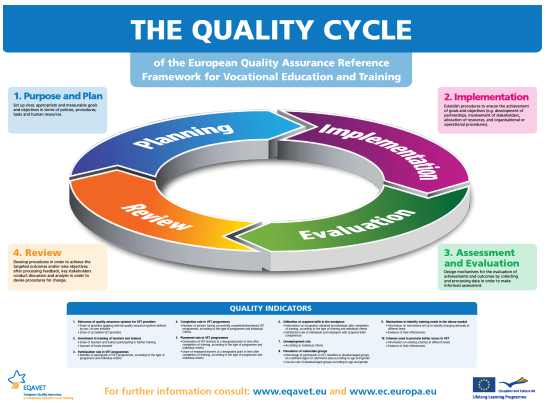The EQAVET cycle provides an on-line tool to support the implementation of the European Quality Assurance Reference Framework. It is a four-step model for VET Systems and Providers for carrying out quality assurance and influencing change. Further, EQAVET provides resources for VET in Employment, Evaluation and Quality Improvement Culture and Increasing Transparency and LLL A Partnership Approach:
Stage 1: PLANNING. Set up clear, appropriate and measurable goals and objectives in terms of policies, procedures, tasks and human resources.
Stage 2: IMPLEMENATION. Establish procedures to ensure the achievement of goals and objectives.
Stage 3: EVALUATION. Design mechanisms for the evaluation of achievements and outcomes by collecting and processing data in order to make informed assessments.
Stage 4: REVIEW. Develop procedures in order to achieve the targeted outcomes/objective. After processing feedback, key stakeholders conduct discussion and analysis in order to devise procedures.

Within the scope of the QSE-VET project, the following provides some examples of how the EQAVET cycle can be used.
Planning: Stage (1) Set up a clear, appropriate and measurable goals and objectives in terms of policies, procedures, tasks and human resources
- Build up a Quality Assurance approach (for the relevance of VET for labour in terms.
- The foundation of QSE-VET’s approach was to focus on EQAVET Indicator 6 and EQAVET Indicator 5)
- Select and structure the consultation and collaboration among the stakeholders (on improving the match in quantity and quality between labour demand and VET supply).
- Establishing the preconditions for a fruitful dialogue on VET relevance can be explored further through WP5_5 Dialogue.
- 6A.1.Guidelines_Part1
- 6A.2.Company Questionnaire
- Define the sector and include all relevant stakeholders in the work (on setting up a Quality Assurance approach for assuring match of labour market demand and VET supply).
- 6A.3.Guidelines_Sector_Statistics_JobProfiles
Implementation: Stage (2) Establish procedures to ensure the achievement of goals and objectives
- Define the sector/professional domain (with participation of all stakeholders).
- 6A.4.SectorMap
- Develop a common language to discuss job content, profile and VET qualification.
- 6A.5.JobProfiling
- 6A.6.JobProfiling
- Get an overview of the data needed and available (to get an overview of the labour market demand and the VET supply).
- 6A.7.LabourMarketData
- 6A.8.NationalOverview
- Support the collaboration on the practical match (of labour demands and VET supply at regional/local level).
- 6A.9.EmployerSurvey
Evaluation: Stage (3) Design mechanisms for the evaluation of achievements and outcomes by collecting and processing data in order to make informed assessments
- Develop and use instruments to measure the match of supply and demand (including measuring the satisfaction of employers and graduates on both quality and quantity).
- 6A.10.AssessmentResults
- Develop and use instruments to predict trends and developments (in labour demand and VET supply).
- Develop a structure and tools for how to share the data, analysis and conclusions (on the match/mismatch of supply and demand in quantity and quality) with all stakeholders.
- 6A.11.Company Assessment
- 6A.12.Company Questionnaire
- 6A.13.Student Questionnaire
- 6A.14.StudentSelfAssessment
Review: Stage (4) Develop procedures in order to achieve the targeted outcomes and/or new objectives
- Develop procedures to use the evaluations for adjustment (on volume and quality of the students).
- Develop procedures for selecting the stakeholders to be involved in the review of the quality and quantity (of the match of labour demand and VET supply).
- Develop procedures for how the use of conclusions from the review stage to the next planning stage (for a better match between labour demands and VET supply).
| Previous | Next |





